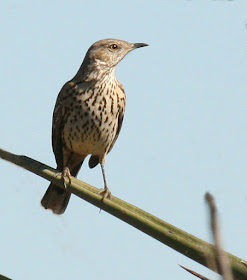Pages
▼
Wednesday, February 23, 2011
Sage Thrasher
There is at least one Sage Thrasher, maybe more, present at CMO. I got lucky and got a better shot of it than I got previously (see Jan 19 post).
Saturday, February 19, 2011
A dirty job but...
...somebody had to do it. The pond in the courtyard was really overdue for the removal of vegetation that didn't belong there... like grass, oleanders (two coming up in the center of the grass), and a total compaction of water lily roots and underwater trunks. Here's the before photo.
I set my camera timer midway through the removal process and got back into the smelly muck. It was necessary to saw the under-muck roots and trunks into manageable chunks in order for me to lift them out of the pond.
I set my camera timer midway through the removal process and got back into the smelly muck. It was necessary to saw the under-muck roots and trunks into manageable chunks in order for me to lift them out of the pond.
The "after" photo below. I left one clump of lilies but in the future I'm not going to let the pond go so long without attention. Note: No frogs or fish were hurt during the performance of this job.
Wednesday, February 9, 2011
K-k-kold Kestrel
I'm in Alpine today. Planning on going back to my oasis Friday or Saturday, by which time it should be warmer. Chill factor tonight is supposed to be -5°. I'm so sick of the cold.
In a few short weeks the male Elf Owls will arrive and reconnoiter the nesting options. When the females arrive a week later, the proud males show their selections to their potential partners. She will make the final decision on which place is chosen. Since I don't know all her criteria, I want to be as prepared as possible.When my birds are happy, I'm happy!
Yesterday I finished putting up all my rescued nest holes. Someone asked me how many I put up and I couldn't answer that. Adding it up later, the count is 9, but two of those don't have woodpecker holes in yet. That may seem like I'm expecting a lot of owls, plus there are some secondary poles still up with holes in them. But between the Ladder-backed Woodpeckers, Ash-throated Flycatchers, and Elf Owls, there never seem to be enough to go around. It isn't unusual to see the owls actually sharing a nest hole with the woodpeckers or flycatchers when options are limited. I've no idea what the outcome of that is. As far as I know, no studies have been done on it, but I've seen it happen. The height and orientation of the holes will probably suit different species and individuals differently, thus another reason for lots of options. Here is some interesting info I found on the net:
Elf Owl breeding territories are very small compared to other small owls. They confine themselves to an area between only 65 and 230 feet from the nest. Also their breeding densities are very high for owls, as many as 11 pairs per square mile.In a few short weeks the male Elf Owls will arrive and reconnoiter the nesting options. When the females arrive a week later, the proud males show their selections to their potential partners. She will make the final decision on which place is chosen. Since I don't know all her criteria, I want to be as prepared as possible.When my birds are happy, I'm happy!







